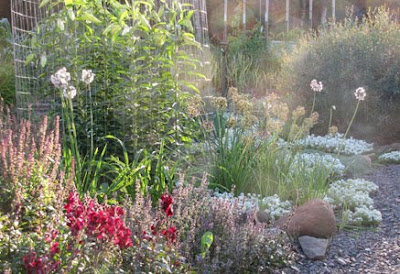1. These are Casa Blanca lilies, a garden classic. Beautiful clear white that only gets more lovely as the sun goes down. Graceful form. Nice fragrance. Tall, sturdy stems. Unfortunately, the deer also favor them. Last year, we didn't get any blooms because of the deer. This year, we doubled up on protection, caging them for much of the growing season and using the motion-detecting sprinkler to scare off would-be diners. The cage isn't the most attractive option, but you do tend to look past it because there are so many other things to see. These are the last of our lilies to bloom, making a grand statement in late August.
2. An asiatic lily called 'Grand Cru' makes its statement in mid- to late July. No fragrance to speak of, but its color more than makes up for that. It's a nice companion for baptisia (the straight blue species.)
 The flowers aren't huge, but there are plenty of 'em.
The flowers aren't huge, but there are plenty of 'em.3. Sometimes you just roll with the punches. We ordered some 'Rodela' lilies (an LA hybrid, a cross between L. longiflorium and asiatic lilies) several years back. When they flowered, they looked like this instead. So not the wine red of 'Rodela.' Pretty, but not where they were planted. Relocated to the front of the house, they mix well with my favorite 'Lauren's Grape' poppies and pink allium. We're still not sure what variety they are, but they have found a home here anyway.
 The poppies are an annual; the allium is a perennial. Both complement the mystery pink lily. That's campanula 'Pantaloons' on the right -- shortly before flowering.
The poppies are an annual; the allium is a perennial. Both complement the mystery pink lily. That's campanula 'Pantaloons' on the right -- shortly before flowering.4. This is the 'Rodela' we were looking for. I love how the flowers are held upright like candelabra. It blooms in late July. Reputable plant purveyors want to make things right with their customers. When we alerted the folks at John Scheeper's about the lily mixup, they sent us the right ones.
 Give 'Rodela' some space so you can better appreciate its form.
Give 'Rodela' some space so you can better appreciate its form.
 These lilies are growing in a bed with catmint and monkshood.
These lilies are growing in a bed with catmint and monkshood.
 Give 'Rodela' some space so you can better appreciate its form.
Give 'Rodela' some space so you can better appreciate its form.5. Many bulb merchants offer mixes where you can get more bulbs for less. It's a good way to go if you're looking to paint a scene with a broad brush rather than a specific color. These dark pink beauties are from such a mix that also included pale pink and white lilies.
 These lilies are growing in a bed with catmint and monkshood.
These lilies are growing in a bed with catmint and monkshood.6. Here's yet another example of why it's important to tag things and keep records. These pale yellow lilies were a surprise in early August. No one here remembers planting them, but I sure do like them. If I only knew what they were, I could order more.












